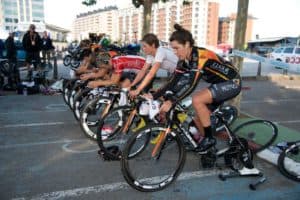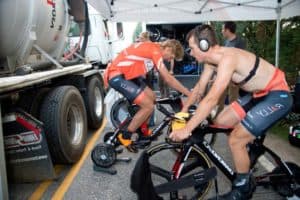The Importance of warming up

The benefits of warm-up before cycling is all about preparing your body for the tasks ahead, but it is also insurance for you not to get burnout or have any other health complication during or after the race you’re competing in.
An efficient warm-up for an athlete must be focused not on the intense training they have already taken care of, but rather on the race itself. A proper warm-up is the best way to assure the effort you are about to make runs smoothly and allows you to achieve the best results you can. Your months – or even years – of preparation will be paid off by success after a good warm-up session.
Independently of your ability level, you need to do an intense warm-up before you compete. The duration of the event is directly related to the intensity of the warm-up session, as it is regarding the time you need to get it done. It means a criterium or time trial requests a more structured and focused warming up session while light pedaling might do the job to get you ready for a long road race, yet this might be changed if the conditions require other kinds of preparation. Have a specific warm-up routine prepared, perhaps aligned with a good playlist, so you can make sure you take all the necessary steps before racing. You can do it on your bike trainer, for instance, and work on your Zones with particular attention to cadence (rpm), power output (watts) and the process to achieve those. Do not forget to cool down afterward to repair the results of a tiring event. You need to protect those sore muscles and after effects of the race itself. The pair assures you your metabolic system is gradually prepared for the effort you are about to make and keeps injuries at large with prevention.
Warm Up Session Times
Regarding timing, it is recommended that you adapt your session to the following event in time, effort and focus. You should warm up as close to the beginning of the race as possible, so you are protected shall any last-minute changes are needed and, also, putting you right next to the start line and close to the start time. Another good tip is to warm up away from circumstances that differ from what you will face during the race; this means core temperature must not be tampered with and, lastly, you should have everything you need as near as possible. It means water, food, towel and music player should not take your time out of your warm-up. These tips might help you a lot, but they are no substitution for a real coach who guides you through all you need to do and have done before the big event. They will assure your session includes all the movements your body needs, muscle stretching, joint movement and boost energy for the race keeping your body at the right temperature you need before the event starts.
Tips for a Good Warm Up
There are some other tips on the matter, such as warm-up guidelines like cycling easily, low-intensity bursts and gradually increased intensity. Stretch after the warm-up so your body will obey you better. Focus on your legs, back and get rid of all the soreness or stiffness you may have accumulated on your body. You need to get your core temperature stabilized and your body flexible, along with the energy build-up required for the event. If you do not get that energy under control during the warm-up session, it will be more difficult for you to access it during your performance at the race. It is the moment one should realize everyone must warm up, from beginners to professional athletes, matching their fitness level and intensity needed, of course. An advantage of warming up using your bike, on a turbo trainer, for instance, is that it assures you that your bike, gears and everything else is working correctly.
Endurance training is vital when you are preparing yourself for a race, so make sure you go through a thorough and comprehensive warm-up exercise plan to prepare your body efficiently. It does not mean you don’t have to warm-up if you are doing many events in a short span of days because you do. Warming up is an effort you must make to keep your body prepared for the next race, but do not forget essential help like hydration and caloric conservation.
There are many kinds of warm-up techniques, focused on the type of race you will be facing, but you should know – or have a good coach discovering – which routines will work best not only for the event but for your body too, as every athlete is different and requires different exercises. When you find out what works best for you, stick with it and improve it as you go. Adapt the warm-up to the race you are about to face.
Criteriums require you more than easy spin, you need velocity, so pay attention to your pace (LT pace and V02-AC pace are recommended) and put some effort into your fast pedaling rather than just to your easy spin skills.
Time trials are unique too and require specific warm-up sessions. Control how hard you go, as you know you may become tired if you go too hard from the start and your performance will suffer as much as you. Some warm-up ideas for these include cadence and endurance training and control, different paces and the always needed easy spins.
Road races are lighter events when it comes to intensity, though they may include hard climbs and surges. The work out required can be shorter but not less complicated. Endurance is valued, as it is pace, mini sprints (jumps) and, as always, easy spins.
No matter the kind of race you are going to, do remember to do all the things required between warming up and the race itself, such as hydrating yourself (or a shot of gel) and using the restroom. You may have your specific warm-up routine according to your fitness level and race, but remember some things are common such as the physiological part of them.

Pre-race warm-ups do vary according to the type of race, and that’s because you need to mirror the movements you will need to do while on the race itself. It is essential that you arrive at the event place early, so you can do all that is needed and still have time for your comprehensive warm-up. Remember you need dynamic stretching, not static, as static stretching has been found to decrease muscular power and some movements too. Dynamic stretches off your bike may include pedaling movements while laying on your back, lunges, skipping, butt kicks, kangaroo jumps and many other exercises such as high knee skips and box jumps. This kind of pre-race warm-up exercises will improve blood flow to your leg’s muscles along with a raise on your heartbeat. You may also ride the race track if they allow you, to get used to the surface but do not forget to stop your exercises at least 15 minutes before the race. After all, you need strength, not fatigue.
Conclusion
We hope you took the right information, but there’s always something to add. Do pre-plan your ability warm-up way before the big day: analyze which kind of warm-up exercises will provide the most benefits for the particular cycling race you are competing in. Do your homework on the terrain and route you will be working on, train as much as you can but arrive at the scene with a plan on how to get your body up to the task ahead, able to perform precisely what’s needed. Trainers are getting more and more popular among cyclists doing their pre-race warm-ups, and there are reasons for that, those pieces of tech may come equipped with exciting features that help the cyclist monitor their warm-ups, such as cadence, pace, and heart rate. Using these apps is an excellent way to know what you are doing and what can be done to improve your warm-up according to the race you are about to enter, but do not get lost in numbers, focus on your body. Consider timing too, along with what kind of warm-up you will do (trainer or road), the warm-up itself, and the cooling down to prep yourself for the gunshot that sets the start of the race.

